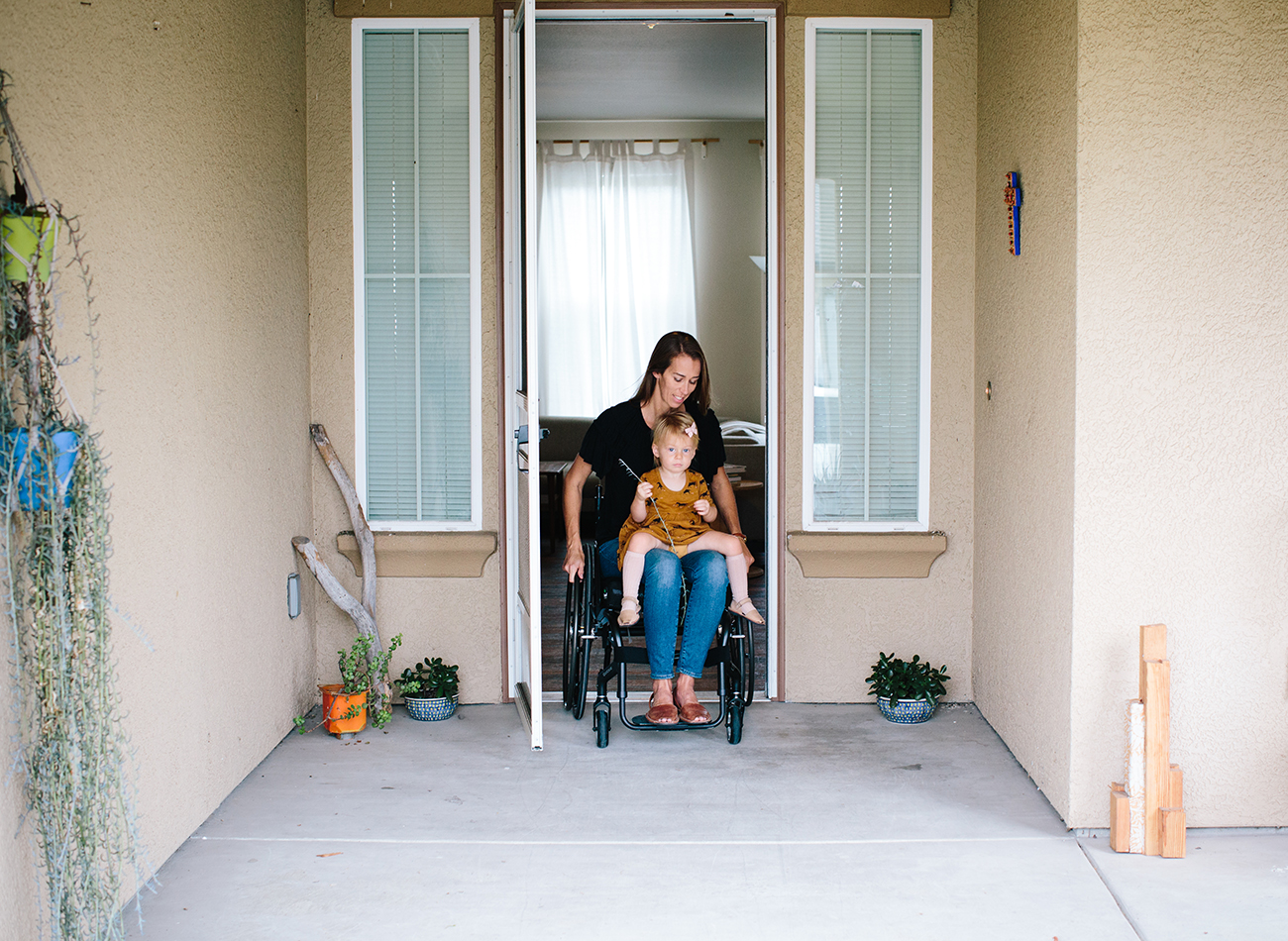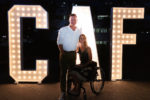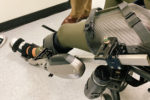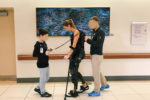
The first thing that happens when you are injured, fall ill, become disabled, or lose someone tragically is that you become invisible in your home or hospital bed. Invisible to the rest of society that would rather not think about the difficult realities of life.
This week marked the 30 year anniversary of the Americans with Disabilities Act mandating that public places must make access, independence, visibility, and equality a reality for disabled people.
I have read many posts by the disabled community expressing mixed emotions. Collectively we’re thankful for the rights protected by this act, but we have first-hand experience of how far our country still has to go in providing access and having a mindset that embraces equality.
No two people have the same experience even if they have the same diagnosis. That’s why I can only share my story and thoughts on this important anniversary.
Until recently I felt I was too newly disabled to speak up about disabled rights. I know, silly, right? I felt like any discrimination or hassles I met with should just be quietly navigated because who was I to speak up after only two years of living life between wheelchairs and leg braces?
I didn’t feel that I could name ableism when I experienced it. Instead I said to myself or others, “They mean well.”
Now it’s different. I can’t be quiet anymore.
Because after 30 years of progress I am witnessing disabled individuals’ rights increasingly being denied during this health crisis. This is what disabled rights activists fought against and why the ADA was enacted.
As a disabled woman I do not have rights because the ADA gave them to me. I have rights because I am a human, and in my belief a child of God. The ADA does not give me those rights, it just protects them.
Similarly you do not have rights because the Constitution gives them to you. You have the right to life, liberty, and the pursuit of happiness because you exist. All the Constitution does is define those rights because something undefined can’t be protected. If the Constitution or the ADA had never been signed we would still be worthy.
When the pandemic began I was quiet out of respect for those suffering. I don’t love the term micro-aggression, and I figured I could just internalize my hurt when most stores had signs ordering “Stand Here” to me, a woman who cannot stand without the aid of a leg brace and crutches and who rolls as often as she “walks” with mobility aids.
But it became harder to turn the other cheek to each slap in the face when the chairs were roped off or removed in public spaces.
It became harder to say to myself “They mean well” when entrances were rearranged due to COVID restrictions with no regard for wheelchair access. When ramps were roped off to make sure everyone “walked” through one entrance to be counted. When the pathways from disabled parking were no longer accessible due to signs, barricades, and other thoughtless rearrangement in the name of public safety.
Ironically I tried to use my wheelchair less since few places were still accessible, but when using my leg brace I try to sit often to take weight off of my leg which is in continual excruciating nerve pain and because I am unstable when standing. Since chairs were removed to keep people from gathering and getting things dirty I had nowhere to be seated when in pain and unstable. Is this making reasonable accommodations for the disabled?
I didn’t say anything because I was intimidated. Who was I to ask for safe access when people were dying from a pandemic? I thought it would just be a few weeks, and then people would remember the disabled. Remember to care, remember our rights. I decided I would wait and try not to let the signs ordering me to stand and the ropes across ramps make me think I wasn’t as human as all the people walking on two feet.
But then it wasn’t a few weeks. We quickly learned that the numbers of those suffering were vast, but also that the virus was not even close to as deadly as initially feared. Still no one remembered the disabled community. Instead they pushed them farther away.
Next the restrooms closed. We were being told to wash our hands to stop the spread, but restrooms were closed “for our health.”
Now people with spinal cord injuries that have to catheter on a specific schedule or those with neurological or other disorders that affect their bladder have an even more difficult time leaving their home because they can’t quickly go into a restroom and return to the errand or meal they were involved in. Now individuals with OCD who need to wash their hands frequently or before eating (as we all should) have to navigate how to leave their home if handwashing is not made available to them.
Schools remained closed.
Disabled students with IEP’s are being denied the in-person education and interaction that they need. Now therapy that should be done in person is in a Zoom call, and students who were making progress navigating social settings are isolated in their homes.
Then came the mask order.
I know from experience that whenever you are the only one with a medical device attached to you, everyone thinks it’s appropriate to ask questions, offer advice, and even cruelly harass. So I know that those who have had to wear masks when no one else was may have had to deal with those challenges. The cancer patient or organ transplant recipient who needed to wear a mask for a season or for their new normal, mostly likely has experienced stares or downright rude comments.
Now the tables are turned. There are many with medical conditions, mental health diagnosis, and disabilities that are not able to wear masks. They are the minority and so as often happens with humans they are facing injustice.
My friend’s daughter struggles with panic disorder. She has fought bravely to manage her illness in order to navigate public places and entering social situations, but cannot do either with a face covering without having a debilitating panic attack. Now she is subjected to verbal harassment each time she leaves her home.
An autistic student I worked with could not tolerate anything different in his daily schedule or clothing. In order to remain calm and functional he had to follow the same routine he had for his entire life. He was not verbal and so could not understand the reason for any deviations. For him there is no such thing as a “new normal.”
Now the people with epilepsy, sensory processing disorders, severe allergies, the list goes on… are facing heightened stigma and cruel harassment if they cannot safely wear a mask.
As I have said, I am not going to share all the details about the health conditions that prevent me from wearing a mask. I shared one aspect in a previous post, but let me share another one with you. When I am not in a wheelchair I wear a full leg brace. When that catches on something as I am trying to ambulate I fall. When you see me up and out of my wheelchair what you don’t realize is how hard I am working not to fall. I fell several times due to limited field of vision from trying to wear a face covering early in the pandemic. Recently I fell hard and didn’t remember anything after. I am assuming I hit my head and lost consciousness. Thankfully I did not have a mask on that could have obstructed my breathing.
There has been a lot of talk about if people with respiratory issues should wear a mask. Why is there not more talk about people living with severe chronic pain ? One of the best ways to get through pain is breath work. Whether masks lower oxygen levels or not, deep breathing is about the act and sound of breathing, and a mask disrupts that. For those who have not lived with chronic debilitating pain, I hope you never have to learn how a flare feels or what lack of proper pain management does to you physically, mentally, and emotionally. When you find something that works – even if it’s just a fraction of pain relief – that can be lifesaving, especially when the few other options can have side effects as serious as opioid addiction.
Not all disabilities are visible, and just because a disability is seen does not mean that the general public gets to decide what that disabled person does or does not need. They certainly do not get to decide that since a person is using a visible assistive device that they know every detail of that person’s medical condition.
We have all heard a lot recently about having a “savior mentality.” The disabled community is another minority who is on the receiving end of this “saviorism.” Faced with this, I would tell myself, “They mean well.”
But again, I can’t do that anymore.
Because when my brace broke recently and I was forced to do all my errands in my wheelchair, people were overly kind. They would approach me, entering the six foot social distancing bubble asking if I needed help, still trying to push my wheelchair for me. When I was able to return to using my brace I returned not only to pain and instability but to people shouting at me, demanding private medical information, calling me names, threatening me, and telling me not to show my face outside my home.
On the 30th anniversary of the ADA, while I was doing an essential task I was told that I should just stay in my home. Literally.
The intent of the ADA was not just to secure access, it is to empower independence. As a disabled person I do not need an able-bodied savior. How I do things looks different, but doing those things myself is essential to my mental health, physical recovery, emotional wellbeing, and sense of worth as a human.
Ableism is pervasive and systemic, and it must be challenged daily.
Ableism lives inside my own mind when I internalize messages I have received my entire life. It comes out of other’s mouths unintentionally.
Ableism decrees what disabled people need and do not need.
Ableism denies access, harasses, and ignores.
Ableism sees the wheels, canes, and other aids more than the human being using them.
Ableism is not comfortable with the diversity of human existence and has a long history of relegating disabled people to institutions, homes, and separate classrooms.
ULTIMATELY ABLEISM IS MOST SATISFIED WHEN THE DISABLED ARE COMPLETELY INVISIBLE.
The ADA was created to ensure ALL people are visible, included, and independent.
So I’m going to speak to every business that blocks a ramp, and to every person who doesn’t understand that independence is just as important as access.
It’s important to assert the rights protected by the ADA, but it’s also crucial not to just stop at the letter of the law. Reasonable accommodations are a good start, but what’s the saying… No one is equal until everyone is equal?
.jpg)






Amber Rook - Thank you for sharing this Sharon. Your experience really opened my eyes and convicted my heart. Especially when you wrote, “ableism is not comfortable with the diversity of human existence.” I like to think I’m comfortable with diversity but I was humbled when I had to stop after reading that quote to admit I am uncomfortable with experiences that don’t look like mine. I appreciate the mercy your message gave me to reflect and ultimately repent for things I hadn’t before considered or looked at in my own heart. Thanks again for sharing. With love and gratitude, Amber
sharon - Thank you for sharing! xoxo